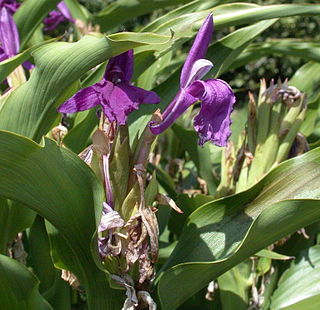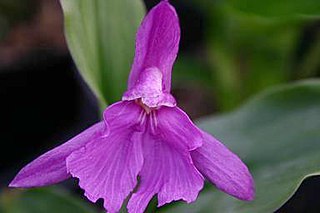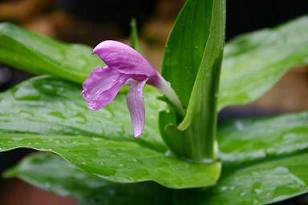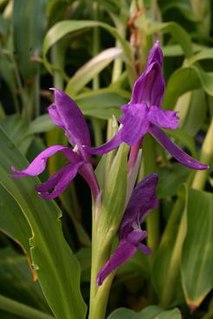
Roscoea is a genus of perennial plants of the family Zingiberaceae. Most members of the family are tropical, whereas Roscoea species are native to mountainous regions of the Himalayas, China and its southern neighbours. Roscoea flowers superficially resemble orchids, although they are not related. The flowers of Roscoea have a complicated structure, in which some of the showy coloured parts are not formed by petals, but by staminodes, sterile stamens which have evolved to become like petals. Some species are grown as ornamental plants in gardens.

Roscoea auriculata is a perennial herbaceous plant occurring in the eastern Himalayas, in Tibet, Bhutan, Nepal and Sikkim. Most members of the ginger family (Zingiberaceae), to which it belongs, are tropical, but R. auriculata, like other species of Roscoea, grows in much colder mountainous regions. It is sometimes grown as an ornamental plant in gardens.

Roscoea humeana is a species of flowering plant in the Zingiberaceae family. It is a perennial occurring in the Sichuan and Yunnan provinces of China. Most members of the ginger family, to which it belongs, are tropical, but R. humeana, like other species of Roscoea, grows in much colder mountainous regions. It is sometimes grown as an ornamental plant in gardens.

Roscoea purpurea is a perennial herbaceous plant occurring in the Himalayas, particularly Nepal. Most members of the ginger family (Zingiberaceae), to which it belongs, are tropical, but species of Roscoea grow in much colder mountainous regions. It is sometimes grown as an ornamental plant in gardens.

Roscoea alpina is a perennial herbaceous plant native to the Himalayas. Most members of the ginger family (Zingiberaceae), to which it belongs, are tropical, but R. alpina, like other species of Roscoea, grows in much colder mountainous regions. It is sometimes grown as an ornamental plant in gardens.

Roscoea kunmingensis is a perennial herbaceous plant native to the mountains of China, being found in Yunnan. Most members of the ginger family (Zingiberaceae), to which it belongs, are tropical, but R. kunmingensis, like other species of Roscoea, grows in much colder mountainous regions.

Roscoea capitata is a perennial herbaceous plant native to the Himalayas, being found in Nepal. Most members of the ginger family (Zingiberaceae), to which it belongs, are tropical, but R. capitata, like other species of Roscoea, grows in much colder mountainous regions.

Roscoea forrestii is a perennial herbaceous plant occurring in the Sichuan and Yunnan provinces of China. Most members of the ginger family (Zingiberaceae), to which it belongs, are tropical, but R. forrestii, like other species of Roscoea, grows in much colder mountainous regions. It is sometimes grown as an ornamental plant in gardens. It was named after George Forrest (1873-1932) who discovered it in Yunnan.
Roscoea cangshanensis is a perennial herbaceous plant native to the mountains of China, being found in Yunnan. Most members of the ginger family (Zingiberaceae), to which it belongs, are tropical, but R. canshanensis, like other species of Roscoea, grows in much colder mountainous regions.

Roscoea praecox is a perennial herbaceous plant occurring in the Yunnan province of China. Most members of the ginger family (Zingiberaceae), to which it belongs, are tropical, but R. praecox, like other species of Roscoea, grows in much colder mountainous regions. It is sometimes grown as an ornamental plant in gardens.
Roscoea bhutanica is a perennial herbaceous plant native to the mountains of Bhutan and Tibet. Formerly regarded as part of Roscoea tibetica, it was recognized as a separate species in 2000. Most members of the ginger family (Zingiberaceae), to which it belongs, are tropical, but R. bhutanica, like other species of Roscoea, grows in much colder mountainous regions.

Roscoea australis is a perennial herbaceous plant found in Burma, to the south of all other members of the genus. Most members of the ginger family (Zingiberaceae), to which it belongs, are tropical, but R. australis, like other species of Roscoea, grows in much colder mountainous regions.
Roscoea brandisii is a species of herbaceous flowering plant in the Zingiberaceae family. It is a perennial found in the state of Meghalaya, India. Most members of the ginger family, to which it belongs, are tropical, but R. brandisii, like other species of Roscoea, grows in much colder mountainous regions.

Roscoea nepalensis is a perennial herbaceous plant found in Nepal. Most members of the ginger family (Zingiberaceae), to which it belongs, are tropical, but R. nepalensis, like other species of Roscoea, grows in much colder mountainous regions.

Roscoea debilis is a perennial herbaceous plant found in Yunnan, China. Most members of the ginger family (Zingiberaceae), to which it belongs, are tropical, but R. debilis, like other species of Roscoea, grows in much colder mountainous regions.
Roscoea schneideriana is a perennial herbaceous plant found in China, in Tibet, Sichuan and Yunnan. Most members of the ginger family (Zingiberaceae), to which it belongs, are tropical, but R. schneideriana, like other species of Roscoea, grows in much colder mountainous regions.
Roscoea ngainoi is a perennial herbaceous plant occurring in the Ukhrul district of Manipur state, India. Most members of the ginger family (Zingiberaceae), to which it belongs, are tropical, but like other species of Roscoea, R. ngainoi grows in much colder mountainous regions.
Roscoea ganeshensis is a perennial herbaceous plant occurring in Ganesh Himal in central Nepal. Most members of the ginger family (Zingiberaceae), to which it belongs, are tropical, but like other species of Roscoea, R. ganeshensis grows in much colder mountainous regions. It is used as an ornamental garden plant, requiring moisture and shade in the summer.

Roscoea wardii is a perennial herbaceous plant occurring from eastern Arunachal Pradesh in India to western Yunnan in China. Most members of the ginger family (Zingiberaceae), to which it belongs, are tropical, but like other species of Roscoea, R. wardii grows in much colder mountainous regions.

Roscoea scillifolia is a perennial herbaceous plant occurring in Yunnan in China. Most members of the ginger family (Zingiberaceae), to which it belongs, are tropical, but like other species of Roscoea, R. scillifolia grows in much colder mountainous regions. As of 2013, the species is only known in cultivation and may be extinct in the wild.













